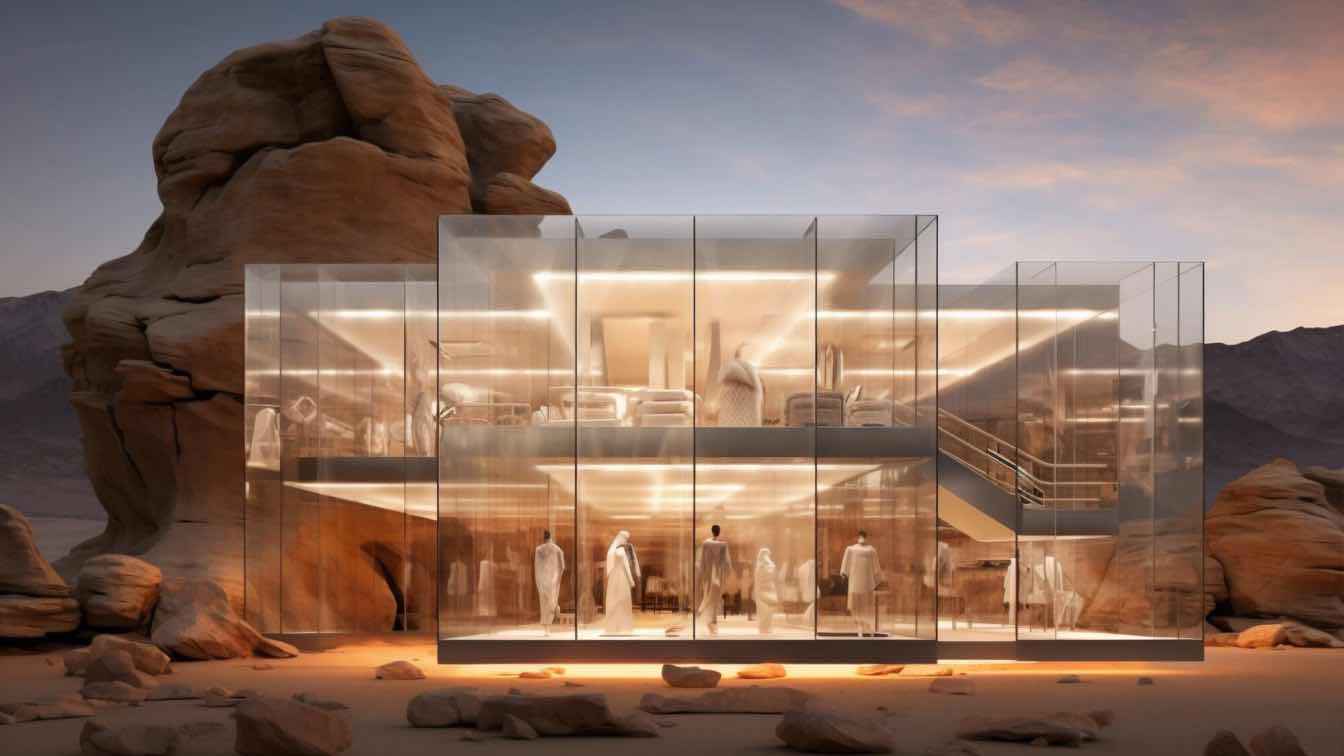Experts estimate that as many as 40% of design development tasks in the architectural and construction industry can be automated using AI while improving efficiency and precision. Additionally, AI in the context of architectural designs further boosts efficiency by reducing waste by as much as 30%.
Technology continues to rapidly further the world as we know it. AI and machine learning have impacted almost every inch of the world today, with significant influence in the architectural design industry.
Learn how generative artificial intelligence (AI) is shaping the architectural industry. Find out how you can use features like stable diffusion and text-to-image models to speed up the architectural design process.
What Does Generative AI Mean in Architecture?
Generative AI in architecture is the use of artificial intelligence in the creation of designs and protocols in the architectural industry. AI uses a combination of training models, including machine learning, data analysis, and natural language processing, to help architects bring ideas and concepts to life. Architects are still largely involved in the design process, even when using gen AI.
Prompt engineering and inputting of training data ensure projects meet necessary requirements while also revolutionizing the innovation and engineering capabilities of the future of the design industry.
Can Machine Learning Models Build Designs by Themselves?
Yes, machine learning models can create building designs by themselves. However, architects can access better, more realistic designs by inputting more detailed data to guide the process. A machine learning model has many built-in capabilities and applications in the industry, including data processing, generative modeling, feedback and improvement suggestions, and deployment and integration processes. However, artificial intelligence isn’t a replacement for the creativity and expert consultation architects offer.
Benefits of Using Generative AI Models for Architects
Whether using generative AI to create a realistic example for clients or to make eco-friendly updates to an existing design, it has many uses in the architectural industry. Generative AI offers many benefits when it comes to architectural design. A few of these benefits include the following.
Can Help As a Skilled Assistant
Perhaps one of the biggest advantages of using generative AI in the architectural industry is as a skilled assistant. Generative AI shouldn’t be considered a replacement for architects and building designers. Instead, it should be considered an effective assistive tool that helps architects in data preparation, image creation, and art design processes - many of the tasks that a skilled assistant would perform.
AI can also be used to help describe project details in a client proposal. Gen AI can be used to pull project requirements and data from documents quickly, helping make faster decisions and leading to a better understanding of the project. Consider AI retrieval augmented generation tools to be an always-available assistant that is open to collaboration and data analysis.
Generate Out of the Box Ideas
One of the most advantageous benefits of using AI in architecture is that it offers unique ideas since computers don’t think like humans. Generative AI can help create unique, out-of-the-box ideas against specific criteria or when up against strict timelines. Using AI models, architects can also rely on these tools to overcome unique challenges.
AI features, like text-to-image, allow architects to input data using a single word or phrase and generate high-quality art designs. Inputting even more details in text allows AI to create more specific building designs, allowing architects to express their creativity via architectural patterns.
Whether using AI technology to create unique design options or making a building more efficient, generative AI is an excellent tool to utilize during the building design process. AI also offers architects the ability to streamline the traditional workflow, which leaves more time to generate new ideas.
Saves Time
AI uses large language models to collect and analyze large amounts of data, helping architects cut down on some of the more time-consuming tasks of building design.
By using these new tools to save time, architects can focus on other important aspects of design, including optimizing building performance, reducing carbon footprint, and maximizing energy efficiency.
Another practical example of how AI can save time in building construction is when comparing project requirements against a proposed model. By inputting large datasets of project needs and then comparing them to an initial model, architects can quickly identify project components they may have missed.
Saves Money
A more efficient process can also help architects reduce costs. AI has the technology to predict risk when given a specific model, which can help avoid costly errors. AI also allows professionals to better account for materials, resources, waste, and labor - leading to less budget variation and greater profitability.
Generative AI provides architectural designers 24/7 access to a collaborative assistant, helps generate unique designs based on the project’s context, and optimizes time and money.
How Generative Artificial Intelligence Can Be Used in the Design Process
The first half of architectural design is made up of multiple design processes, including pre-design, schematic design, and design development. Integrating an AI model during each of these phases has the potential to revolutionize the design process.
Here are a few ways gen AI can assist architects in the design processes.
Concepting
Gen AI is especially beneficial during the early stages of a project design, including when creating prototypes. An architect may submit multiple models to engineers before perfecting and completing the design.
Through AI, architects can generate new images and prototypes much quicker, speeding up this design step. In addition to initial concepts, AI-generated data also helps teams collaborate and work together more efficiently.
The ability to save time also allows teams to create more concepts, which can then be presented to the client.
Strategy and Imaging
Gen AI can quickly create architecture design plans while accounting for building requirements and materials. The ability to quickly review large amounts of data helps Gen AI create designs and implement strategy.
It also helps those in the architecture industry better visualize sites via a generated image, which they can then create design strategies based on real data. This significantly helps with meeting regulatory compliance or environmental impact guidelines.
Test and Optimize Design Features
Generative AI tools make it easier to test and optimize specific designs that can help architects create custom and unique plans. Generated images are realistic and allow professionals to identify and improve upon design flaws.
Testing and optimizing design features allow designers to meet unique building requirements better. Architectural and engineering professionals can use pre-input data to compare future designs against efficiency, structural integrity, and sustainability goals.
Building Simulation
The ability to generate high-quality images based on designs and concepts can help speed up the process. Generative AI can assist throughout different parts of the building design, including creating simulations, editing images, and compiling and editing videos.
Turning a design image into a video allows architects and clients to visualize the project’s outcome better, including the flow of space and amenity layout. A more detailed example of the project outcome can lead to faster and more frequent approvals.
2D and 3D Rendering
Both 2D and 3D imaging are important components of architectural designs. Turning an example photo into a two or three-dimensional image can be a time-consuming task and one that makes on-the-go changes to a project even more difficult.
Generative AI can render these images faster than traditional practices, helping speed up the design process. The ability to quickly create an accurate 2D or 3D image based on model requirements can also help architects identify areas of improvement before moving the project on to the engineering phase. 2D and 3D image rendering also helps with fine-tuning projects, accounting for a project's small yet important details, from window placement to fixture material.
AI offers many practical applications in the architecture industry. From creating hyper-focused images to fine-tuning existing plans, generative AI has the power to maximize efficiency in each design phase.
Current Limitations of Generative AI in Architectural Design
While generative AI offers many benefits to the architectural design industry, it’s important also to note its limitations.
Designs aren’t always practical or realistic: While AI-generated images can help with the design process and collaboration, every design it outputs may not be practical or realistic.
Architect input is still required: Engineers and designers will still need to compare architecture patterns and regulatory rules against AI designs.
Eventual generic building designs: Without the input of designers, focusing solely on AI in architecture could lead to generic building designs.
Errors in data accuracy: It’s also important to note that AI designs aren’t without error. AI may miss important design processes, like accurately predicting costs, identifying waste output, and calculating risk. The outcome of AI models depends on the quality of data input, which could, in some cases, lead to design errors.
As a general rule, generative AI is an excellent tool when planning and coming up with new plans, but a sound design still requires the expert input of an architect. The expertise of a licensed architect is also still a crucial part of meeting the specific requirements of a project as set by clients.
Not sure how to leverage the benefits of gen AI in your business? Stellar SEO offers expert-level search engine optimization services to a wide range of industry experts, including real estate professionals, architect design professionals, engineers, and other professionals, helping to provide a practical application to gen AI-based services.
From Prompt to Structure
From prompt to structure - AI is the future, whether designing buildings or fine-tuning a current project. However, learning the strengths and challenges of AI can help architects and design professionals use its learning models to maximize budgets and save time. Using gen AI in the context of ideation and design planning offers many beneficial tools that can lead to a more accurate and creative industry as a whole.





